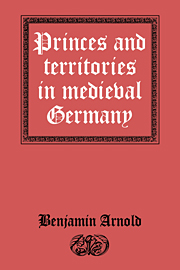Book contents
- Frontmatter
- Contents
- Acknowledgements
- List of abbreviations
- Introduction
- PART I CROWN AND PRINCE
- PART II PRINCELY TITLE AND OFFICE
- PART III DYNASTIES, PRELATES, AND TERRITORIAL DOMINION
- 8 From consanguinity to dynasty?
- 9 Material foundations: colonization, forest, towns, and communications
- 10 The reform of regional jurisdictions in the twelfth and thirteenth centuries
- 11 The anatomy and nomenclature of princely dominion, 1150–1330
- 12 Feuds, inheritance, and partition
- 13 Region and territory: effects and outcome
- Conclusion
- Index
8 - From consanguinity to dynasty?
Published online by Cambridge University Press: 03 December 2009
- Frontmatter
- Contents
- Acknowledgements
- List of abbreviations
- Introduction
- PART I CROWN AND PRINCE
- PART II PRINCELY TITLE AND OFFICE
- PART III DYNASTIES, PRELATES, AND TERRITORIAL DOMINION
- 8 From consanguinity to dynasty?
- 9 Material foundations: colonization, forest, towns, and communications
- 10 The reform of regional jurisdictions in the twelfth and thirteenth centuries
- 11 The anatomy and nomenclature of princely dominion, 1150–1330
- 12 Feuds, inheritance, and partition
- 13 Region and territory: effects and outcome
- Conclusion
- Index
Summary
For a long time it has been claimed that a significant transformation occurred within the structure of the German aristocratic family between the tenth and the twelfth centuries, a marked shift from widely delineated kindreds to more narrowly defined lineages, from consanguinity to dynasty. It is thought that this tendency was supported by castle-building, the adoption of family toponymies from castles, and the evolution of dynastic self-awareness inspired in part by aristocratic patronage of reformed monasticism. This shift has been discerned not only in family perception but also to some degree in marriage strategy and inheritance-patterns, so it would count as a strong social force conducive to the onset of more regionalized, territorial forms of lordship in Germany. But did it really take place?
Like other hereditary landowning aristocracies, the East Frankish and German nobles had always possessed a pronounced sense of family importance. Nobility was seen as a quality inherited through blood. The kindreds belonging to the aristocratic order married amongst themselves. Their castles, retinues, and lands descended amongst them by hereditary right, and so did most of the titles and jurisdictions which they enjoyed. Although this aristocracy was exclusive and endogamous, and exhibited many of the characteristics of a caste, its inner customs were surprisingly flexible, and the actual rules governing descent within kindreds and the devolution of their property were not at all conservative or immutable. The nobility did not consciously cling to some fixed or sacrosanct kindred organization over the generations and centuries.
- Type
- Chapter
- Information
- Princes and Territories in Medieval Germany , pp. 135 - 151Publisher: Cambridge University PressPrint publication year: 1991



